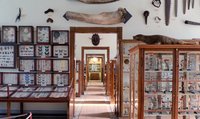Magisches Probierbrett aus der Herstellung des Nürnberger Mechanikers Wilhelm Burucker, das offenbar dem Erraten von Gedanken diente. Burucker hatte in seinem Sortiment von Spielen und mechanischen Belustigungen dieser Art circa 20 Objekte im Angebot. Typisch für seine Produkte ist das rötliche, gemusterte Kleisterpapier. Oben auf einem Aufkleber bezeichnet als "Magisches Probierbret", umringt von den Symbolen von neun Sternzeichen, unten ein Etikett mit der originalen Linck-Nummer "398".
Belegt im Linck-Index III (1787), S. 132, No. 398: "Ejusmodi machina. Desgleichen das magische Probierbret. (aufbeh. No 398)."
en

